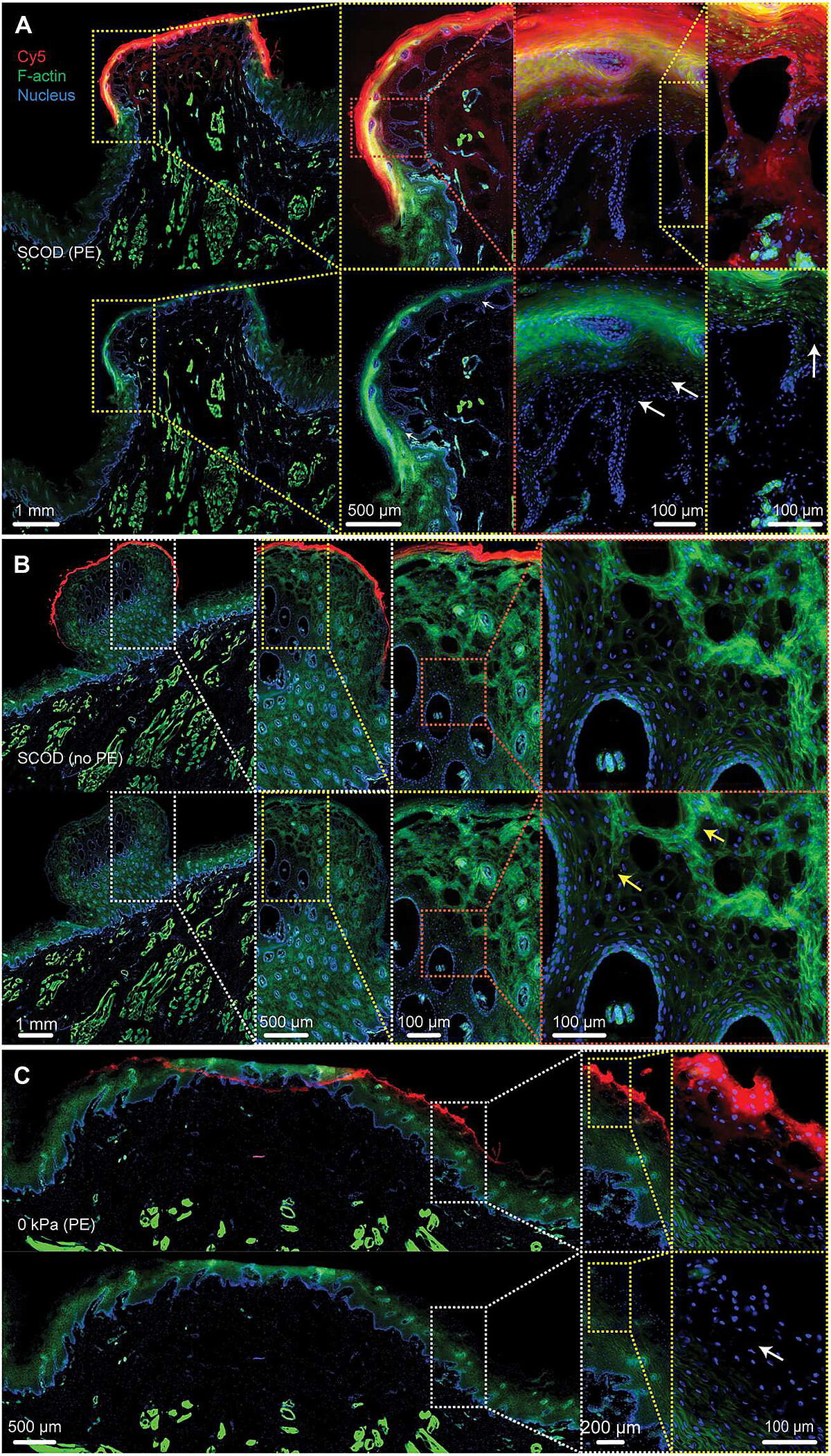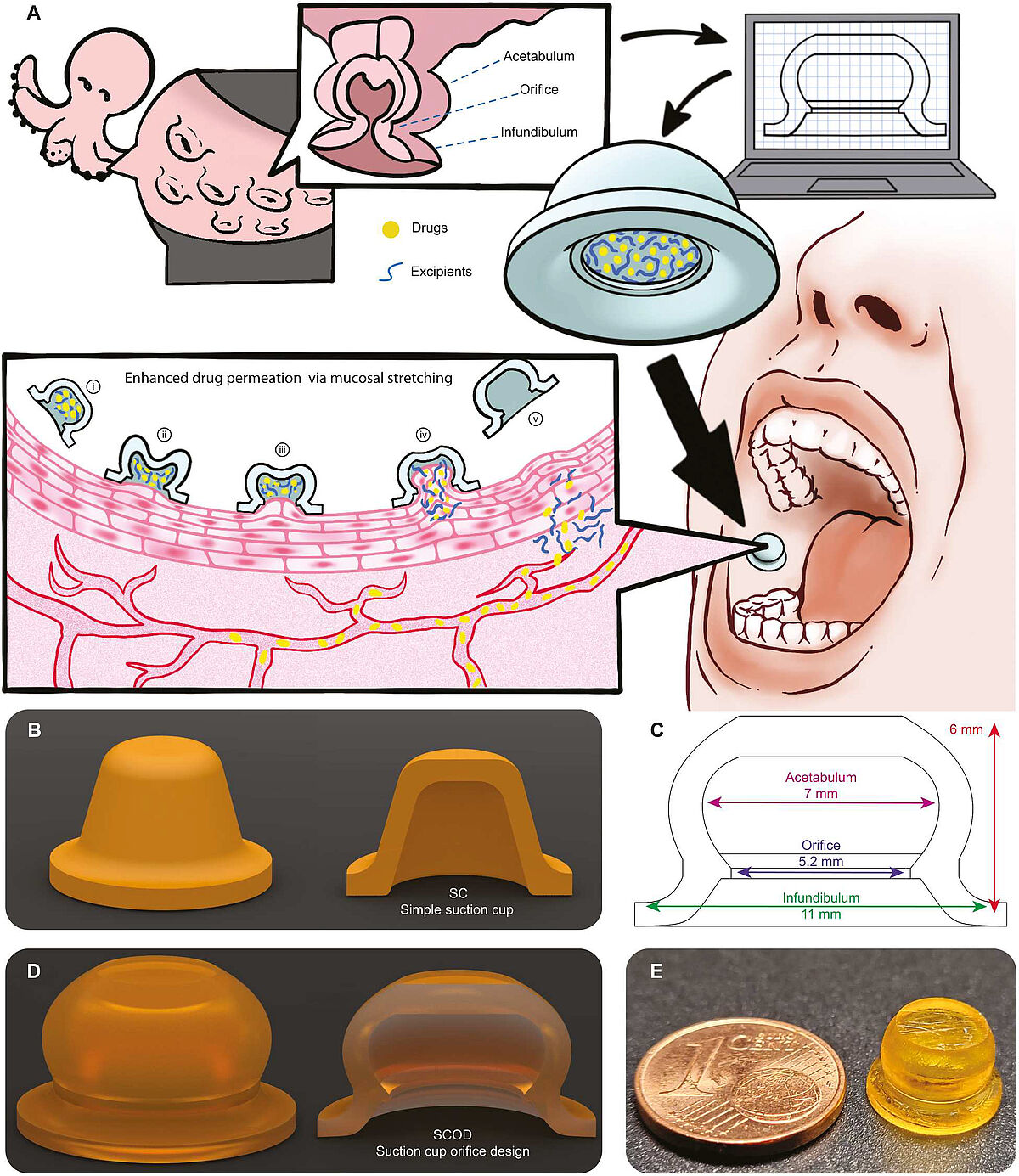Buccal drug administration is a promising alternative to oral drug formulations, which suffer from metabolic breakdown before reaching systemic circulation. An innovative design for buccal drug delivery by David Klein Cerrejon and co-workers, described in Science Translational Medicine, surpasses the efficacy of current buccal formulations. Inspired by octopus suckers, the drug suction patch can mechanically deform the buccal mucosa membrane and, with the help of permeation enhancers (PEs), increase drug absorption. The buccal drug delivery device, which is similar in size to a commercial cough drop, can efficiently deliver peptide drugs via the buccal route in an easy-to-administer manner.
Benefits of buccal drug delivery
An important route of drug administration is buccal drug delivery, whereby the desired drug is administered between the gums and the inner buccal mucosa membrane lining of the mouth cheek, achieving local or systemic effects. Buccal drug delivery avoids problems associated with oral drug delivery such as low bioavailability due to a reduction in the concentration of active drug by the first pass effect and gastrointestinal drug degradation. Additionally, complex manufacturing and application procedures required for invasive transdermal drug delivery can be avoided. Despite these benefits, few buccal formulations are currently on the market, and those available are only able to deliver low molecular weight (MW) drugs. This is because crossing the buccal mucosa is not straightforward.
Difficulties of drug permeation via the buccal route
Composed of 40-50 layers of non-keratinized cells, the buccal mucosa in humans is a flexible surface able to withstand stretching. However, the outermost epithelial layer is rich in lipids, creating a barrier that makes drug permeation difficult. To aid this process, permeation enhancers (PEs) —which essentially make holes in the lipid-rich epithelial layers — can increase buccal drug delivery. But when used alone, PEs only achieve low bioavailability of peptide drugs and suffer from high variability. Therefore, additional technologies are needed to deliver drugs through the buccal route efficiently.

Octopus-inspired technical breakthrough
A new study published in Science Translational Medicine by David Klein Cerrejon et al., describes an innovative buccal drug device that combines the non-invasive mechanical forces that stretch the buccal membrane and boost drug absorption when used with PEs. The buccal drug delivery system can be used to deliver peptide drugs with a range of MWs and has a design inspired by nature.
At ETH Zurich in Switzerland, David Klein Cerrejon and co-workers designed a drug suction patch based on octopus suckers. These structures are found on the tentacles of cephalopods, such as octopuses. In nature, the bowl-like structures can grasp complex-shaped objects (prey and substratum) with solid suction power, forming a water-tight seal. The researchers recreated this structure in the lab with a non-toxic and biodegradable elastomer. Like an octopus sucker, the suction patch supported a precise and continuous negative pressure inside the patch, which allowed the patch to adhere firmly to the buccal mucosa.
How do the octopus-inspired drug patches work?
The suction patches could be loaded with over 50 mg of peptide drug. To further study drug penetration from the drug suction patches through the surface epithelial layers, an ex vivo study in porcine buccal mucosa was employed. Drug permeation was followed by fluorescently labeling a peptide drug and calculating the penetration distance from the mucosal surface. Upon application to the buccal membrane, the suction drug patch maintained its structure to avoid drug leakage. Histological staining showed that mechanical stretching could deform the filamentous actin meshwork of the mucosa barrier, causing a decrease in the thickness of the mucosal barrier, which likely enabled the diffusion of PEs into the deeper layers, allowing more efficient peptide drug delivery.
The tissue integrity and layers remained uncompromised and intact. The suction patch could be removed upon drug permeation into the buccal mucosa. Higher doses of PE increased penetration depth, showing a certain level of personalization could be needed for specific populations, such as pediatric patients. Once efficient drug penetration was achieved, the next step was to assess whether the peptide drug reached circulation.

Achieving higher bioavailability of peptide drugs
As the buccal mucosa is non-keratinized and structurally and functionally similar to humans, a beagle dog model was used to study bioavailability — the rate and extent at which the active drug was absorbed and reached circulation. A peptide drug suffering from low bioavailability, Desmopressin, was selected to test the device's efficacy. Desmopressin is used for several conditions, from treating diabetes to inherited bleeding disorders. Using the suction patch and a PE — sodium taurocholate (NaTaC) — resulted in a bioavailability reaching two orders of magnitude higher (16.4%) than the orally delivered tablet form of Desmopressin.
Unlike current buccal formulations, the suction patch also efficiently delivered high MW peptide drugs. The buccal delivery of Semaglutide with the suction patch, which has a MW four times higher than Desmopressin, was comparable to systemic exposure of the approved oral tablet form, Rybelsus. Moreover, the device achieved less variability between animals, another problem of current formulations. As the device was safe in dogs and caused no swelling or histological changes after administration of the suction patches, it was then essential to test whether the device was easy to use and comfortable for human patients.
Testing usability of the device
To test the comfort of the device, 40 healthy individuals were assessed. The participants were able to apply the suction patches by themselves by pressing them to the buccal mucosa. Once released, the patches adhered firmly for the whole 30-min application time without causing any discomfort. The participants expressed a clear preference for using the buccal drug delivery device over receiving injections.
Bio-inspired suction patches as replacements for injectable medicines
The buccal suction patch delivery system described by David Klein Cerrejon and his colleagues offers a painless alternative to the parenteral administration of peptide drugs and achieves better bioavailability than oral tablet forms.Suction patches with two peptide drugs, Desmopressin and Semaglutide, achieve impressive bioavailability rates. Furthermore, the well-thought-out design of the buccal suction patch minimizes discomfort and allows for easy application by patients. This first description of mechanical stretching and chemical PEs facilitates efficient, non-invasive drug delivery directly into the bloodstream and has the potential to replace injections of routine medication.
For further information on this publication, please get in touch with us.
